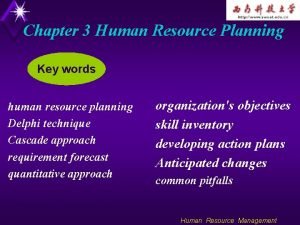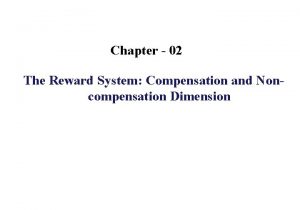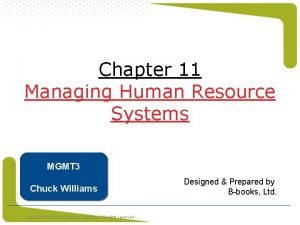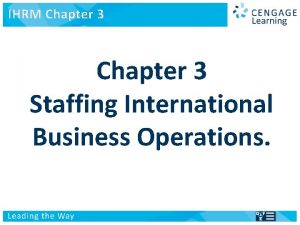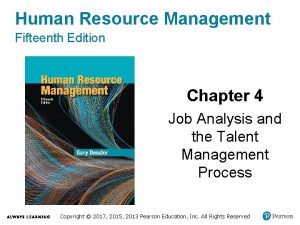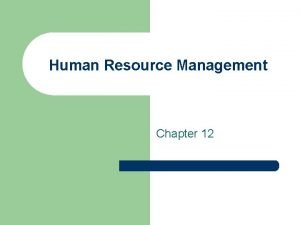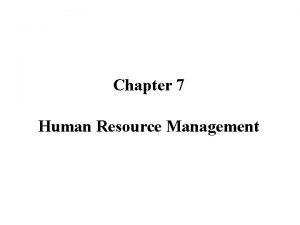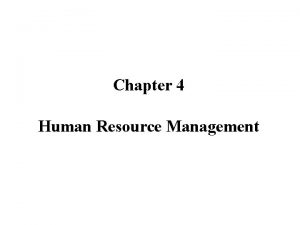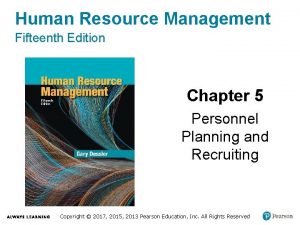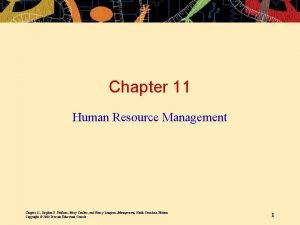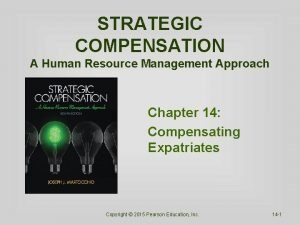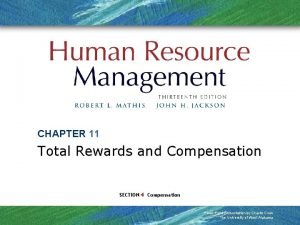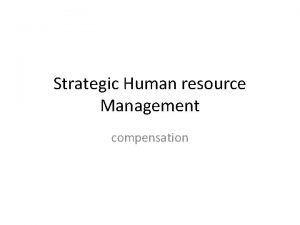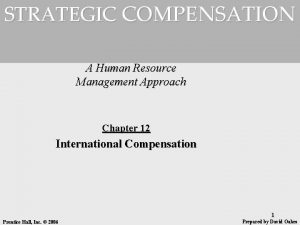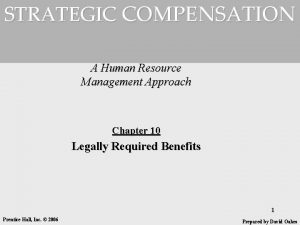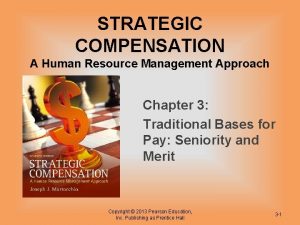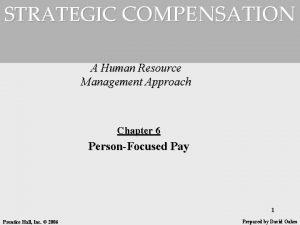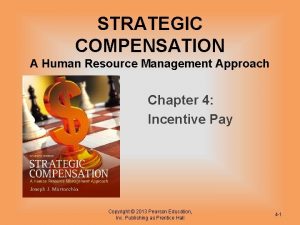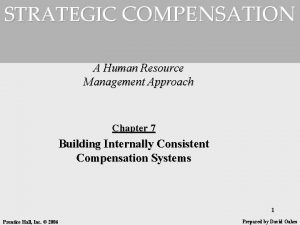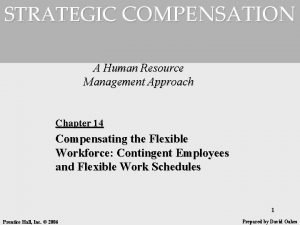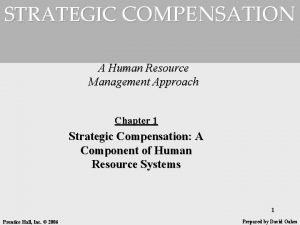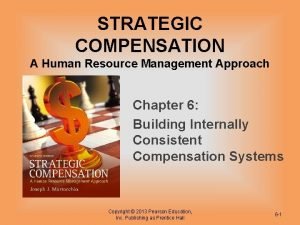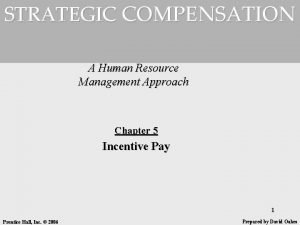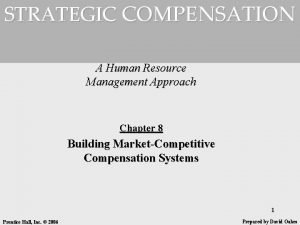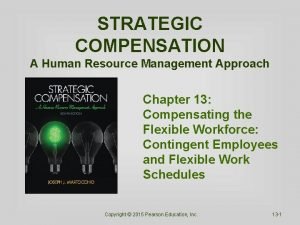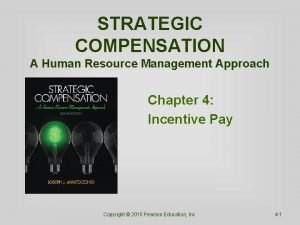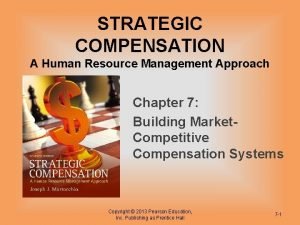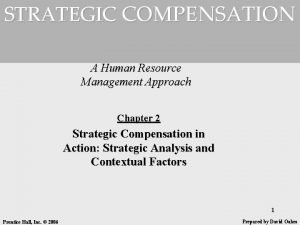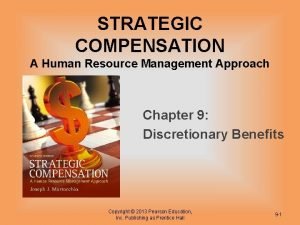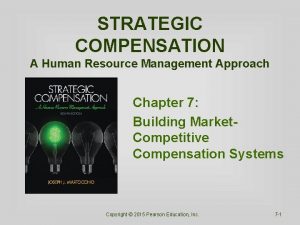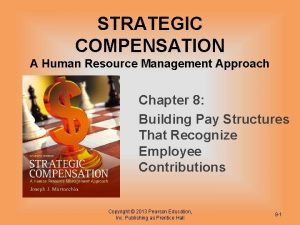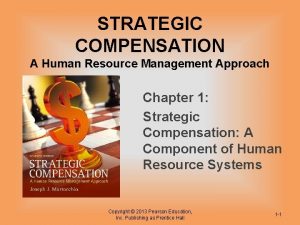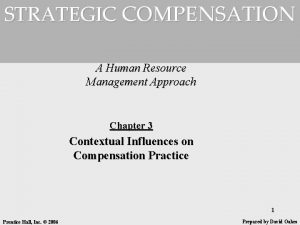STRATEGIC COMPENSATION A Human Resource Management Approach Chapter






























- Slides: 30

STRATEGIC COMPENSATION A Human Resource Management Approach Chapter 15: Pay and Benefits Outside the United States Copyright © 2015 Pearson Education, Inc. 15 -1

Learning Objectives 1. Explain the differences between pay and benefits in the United States and in countries around the world. 2. State the total costs of hourly compensation in manufacturing settings around the world. 3. List the countries that impose minimum wage rates. Copyright © 2015 Pearson Education, Inc. 15 -2

Learning Objectives 4. Summarize the paid time off benefits in at least two countries. 5. Briefly summarize the protection benefits such as retirement, health care, and social security in at least two countries. Note: Following introductory information, the material will be presented by country, incorporating the learning objectives. Copyright © 2015 Pearson Education, Inc. 15 -3

Introduction • Globalization: high level of interconnections between economies • U. S. employers will increasingly conduct business with variety of other countries • Former underdeveloped parts of the world experience tremendous economic, trade, and standard of living growth Copyright © 2015 Pearson Education, Inc. 15 -4

North America—NAFTA • Mexico, Canada, and the United States are part of a trade bloc known as NAFTA—the North Atlantic Free Trade Agreement of 1993 • The labor side of NAFTA is the North American Agreement on Labor Cooperation (NAALC) • Created to promote cooperation between trade unions and social organizations for better work conditions Copyright © 2015 Pearson Education, Inc. 15 -5

Comparative Hourly Costs • In 2011, the hourly cost to pay a manufacturing worker employed in the United States expressed in U. S. dollars was $35. 33 • This is compared to an hourly cost of $6. 48 in Mexico and $2. 01 in the Philippines • It is, however, much higher in Germany and Norway, where it is $47. 38 and $64. 15, respectively Copyright © 2015 Pearson Education, Inc. 15 -6

Size of a Country’s Economy Copyright © 2015 Pearson Education, Inc. 15 -7

Canada: Wage and Salary • Statutory minimum wage law • At the federal level, there is an obligation placed upon provincial governments to establish minimum rates of pay by or under an act of the legislature • In 2012, Alberta currently had the lowest minimum wage rate in Canada ($9. 95/hour) • The highest rate ($11. 00/hour) can be found in Nunavut Copyright © 2015 Pearson Education, Inc. 15 -8

Canada: Paid Time Off Benefits • Employees are entitled to between eight and nine annual paid holidays as well as two weeks paid vacation time along with a sum of money as vacation pay (increasing to three weeks after six years of employment) • The amount of vacation pay is equal to 2% of employee’s pay for the preceding year per week of vacation • Employees are eligible for a total of 17 weeks’ benefits during pregnancy and after childbirth Copyright © 2015 Pearson Education, Inc. 15 -9

Canada: Protection Benefits • Two state pension plans, one for Quebec residents only and one for the rest of Canada • Medical and basic hospital care paid for by provincial medical insurance plans with compulsory coverage for all residents • Even though public health plans normally do not provide employed persons with prescription drugs except while they are hospitalized, additional benefits are provided by private supplementary insurance by employers, including dental and vision care Copyright © 2015 Pearson Education, Inc. 15 -10

Mexico: Wage and Salary • Mexican government requires that two minimum wage rates be applied: – The first, general minimum wage, applies to all workers and the amount depends upon the region of the country – The second is the occupational minimum wages that are higher than the general minimum wages • Occupations that require greater skill, knowledge, and experience are compensated at higher rates Copyright © 2015 Pearson Education, Inc. 15 -11

Mexico: Paid Time Off Benefits • Workers entitled to paid time off during public holidays and workers required to work during a mandatory holiday are entitled to double pay • Female employees entitled to maternity leave— six weeks’ leave prior to giving birth and six weeks’ leave after birth on full salary • Employees are entitled to six vacation days after being employed for one year and to two more days for each subsequent year, up to a maximum of twelve days Copyright © 2015 Pearson Education, Inc. 15 -12

Mexico: Protection Benefits • Social security programs in Mexico are administered by the Mexican Social Security Institute • Medical services provided directly to patients through the health facilities of the Mexican Social Security Institute Copyright © 2015 Pearson Education, Inc. 15 -13

South America • Biggest trade bloc in South America used to be Mercosur, or the Southern Common Market, composed of Argentina, Brazil, Paraguay, Uruguay, and Venezuela as the main members and Bolivia, Chile, Colombia, Ecuador, and Peru as associate states • Brazil, Argentina, Colombia, and Chile are the largest economies in South America. On the other hand, Argentina, Chile, and Uruguay have the best human development index Copyright © 2015 Pearson Education, Inc. 15 -14

South America (cont’d) • Second-biggest trade bloc was the Andean Community of Nations made up of Bolivia, Colombia, Ecuador, Peru, Venezuela, and Chile • Trade blocs merged as of a declaration signed on December 8, 2004, at the Third South American Summit and formed one large trade bloc known as the South American Community of Nations that plans to model itself on the European Union Copyright © 2015 Pearson Education, Inc. 15 -15

Brazil: Wage and Salary • Minimum wage imposed • In accordance with the Federal Constitution, the minimum wage rate is nationally uniform and set by law • Fixed by a Provisional Measure, namely an act of the executive having the force of law, in accordance with Article 62 of the Federal Constitution and placed before Congress for conversion into law • In 2011, this wage was 545 R$ (Reais) Copyright © 2015 Pearson Education, Inc. 15 -16

Brazil: Protection Benefits • Comprehensive Social Security benefits • Pensions – Employees contribute between 7. 65% and 11% of gross earnings – Employers are required to contribute 20% of payroll • Medical services are provided directly to patients in rural and urban areas through the Unified Health System Copyright © 2015 Pearson Education, Inc. 15 -17

European Union • European Union (EU): unique international organization that aims at becoming an economic superpower while still retaining quintessential European practices such as high levels of employment, social welfare protection, and strong trade unions • Under the laws of all member states, employers must provide employees with a written document about the terms of the employment contract Copyright © 2015 Pearson Education, Inc. 15 -18

European Union (cont’d) • The concept of “employment at will” does not exist in the EU as in the United States • The EU makes use of directives and community legislations to ensure that some minimum standards are adopted by member states Copyright © 2015 Pearson Education, Inc. 15 -19

Germany: Wage and Salary • The German government does not mandate a minimum wage, except for construction workers, electrical workers, janitors, roofers, painters, and letter carriers; set by collective bargaining agreements in other sectors of the economy and enforceable by law • Two types of collective agreement - Association agreements are made between trade unions and employers’ associations - Company agreements are made between trade unions and individual employers Copyright © 2015 Pearson Education, Inc. 15 -20

Germany: Paid Time Off Benefits • The statutory minimum vacation has been set at 24 working days • Younger workers have a right to a vacation of 25 – 30 working days; disabled workers have an additional 5 days of vacation • Under the terms of the Maternity Leave Law, time away from work as a result of maternity leave or other limits on work by pregnant women and mothers must be counted as time worked for vacation time determination Copyright © 2015 Pearson Education, Inc. 15 -21

Germany: Protection Benefits • Statutory pension system analogous to the Social Security system in the United States • German laws stipulate guidelines for minimal health welfare of workers • For blue-collar workers (and some whitecollar workers) mandatory state health insurance premiums are borne 50% by the insured and 50% by the employer Copyright © 2015 Pearson Education, Inc. 15 -22

Asia • Asia has several trade blocs – Asia-Pacific Economic Cooperation – Asia-Europe Economic Meeting – Association of Southeast Asian Nations – South Asian Association for Regional Coop. • Wide variation and diversity in the world’s largest and most populous continent—no unifying economic body like the EU or NAFTA that represents all the countries of Asia • In 2013, China is the largest economy in Asia, followed by India and Japan Copyright © 2015 Pearson Education, Inc. 15 -23

India: Wage and Salary • Minimum wage is fixed by an authority dual system • Minimum wage rates are determined by the government for certain sectors, and a collective agreement determines others • Minimum wage rates for occupations that are largely nonunionized or have little bargaining power may be set in accordance with the Minimum Wages Act, 1948 Copyright © 2015 Pearson Education, Inc. 15 -24

India: Paid Time Off Benefits • Leave is usually calculated for each year based on the number of days worked in the previous year • If worker does not take all of the accumulated leave, it is allowed to roll over to the succeeding calendar year up to a maximum of 30 days • There is no statutory provision of paternity leave, but maternity leave is allowed in the form of paid time off and possible medical bonus Copyright © 2015 Pearson Education, Inc. 15 -25

India: Protection Benefits • 1952: employees’ provident funds • 1995: employees’ pension scheme • 1995: national social assistance program • Health care through Employees’ State Insurance Corporation • India’s per capita expenditure on health care at the international dollar rate was $109 in 2006 Copyright © 2015 Pearson Education, Inc. 15 -26

China: Wage and Salary • According to China’s Labour Act, 1994, the State possesses the responsibility to implement a system of guaranteed minimum wages • There is no national minimum wage rate in China; instead, minimum wage is set by region • In 2011, the highest minimum wage: Gaunghzho Province (1, 300 yuan monthly) • The lowest minimum wage: Jiangxi and Anhui provinces (500 yuan monthly) Copyright © 2015 Pearson Education, Inc. 15 -27

China: Paid Time Off Benefits • Employees who have worked for one or more years are entitled to paid annual leave but there are no binding laws about this • National policy guidelines recommend 7 to 14 days • Employees who have worked for more than one year are entitled to “home leave” if they do not live in the same place as their spouse or parents • Women are entitled to no less than 90 days of maternity leave starting 15 days prior to birth Copyright © 2015 Pearson Education, Inc. 15 -28

China: Protection Benefits • Social insurance and mandatory individual accounts • Coverage includes employees in urban enterprises and urban institutions managed as enterprises and the urban self-employed • Basic Medical Insurance Fund: pooled fund and personal accounts • Employees’ contributions go directly to their personal accounts and 30% of employer contributions are paid into this account • Per capita expenditure on health care at the international dollar rate was $379 in 2010 Copyright © 2015 Pearson Education, Inc. 15 -29

All rights reserved. No part of this publication may be reproduced, stored in a retrieval system, or transmitted, in any form or by any means, electronic, mechanical, photocopying, recording, or otherwise, without the prior written permission of the publisher. Printed in the United States of America. Copyright © 2015 Pearson Education, Inc. 15 -30
 Cascade approach in human resource management
Cascade approach in human resource management Compensation and non compensation dimensions
Compensation and non compensation dimensions Time management in human resource management
Time management in human resource management Human resource management in retailing
Human resource management in retailing Management is universal and everywhere
Management is universal and everywhere Strategic human resource
Strategic human resource Chapter 2 human resource management
Chapter 2 human resource management Chapter 9 human resources management
Chapter 9 human resources management Chapter 11 human resource management
Chapter 11 human resource management Chapter 1 introduction to human resource management
Chapter 1 introduction to human resource management Intro to human resource management
Intro to human resource management Human resource management lecture chapter 1
Human resource management lecture chapter 1 Human resource management lecture chapter 1
Human resource management lecture chapter 1 Determinants of staffing choices
Determinants of staffing choices Human resource management chapter 4
Human resource management chapter 4 Function of hrm
Function of hrm Chapter 7 human resource management
Chapter 7 human resource management Chapter 7 human resource management
Chapter 7 human resource management Human resource management chapter 4
Human resource management chapter 4 Project management chapter 4
Project management chapter 4 Replacement chart
Replacement chart Human resource management chapter 5
Human resource management chapter 5 Chapter 11 human resource management
Chapter 11 human resource management Strategic compensation
Strategic compensation Industrial organization model of above average returns
Industrial organization model of above average returns Strategy analysis and choice largely involves making
Strategy analysis and choice largely involves making Compensation approach
Compensation approach Incremental approach in strategic management
Incremental approach in strategic management Strategic management a competitive advantage approach
Strategic management a competitive advantage approach Commander approach in strategic management
Commander approach in strategic management Project human resource management pmbok ppt
Project human resource management pmbok ppt
